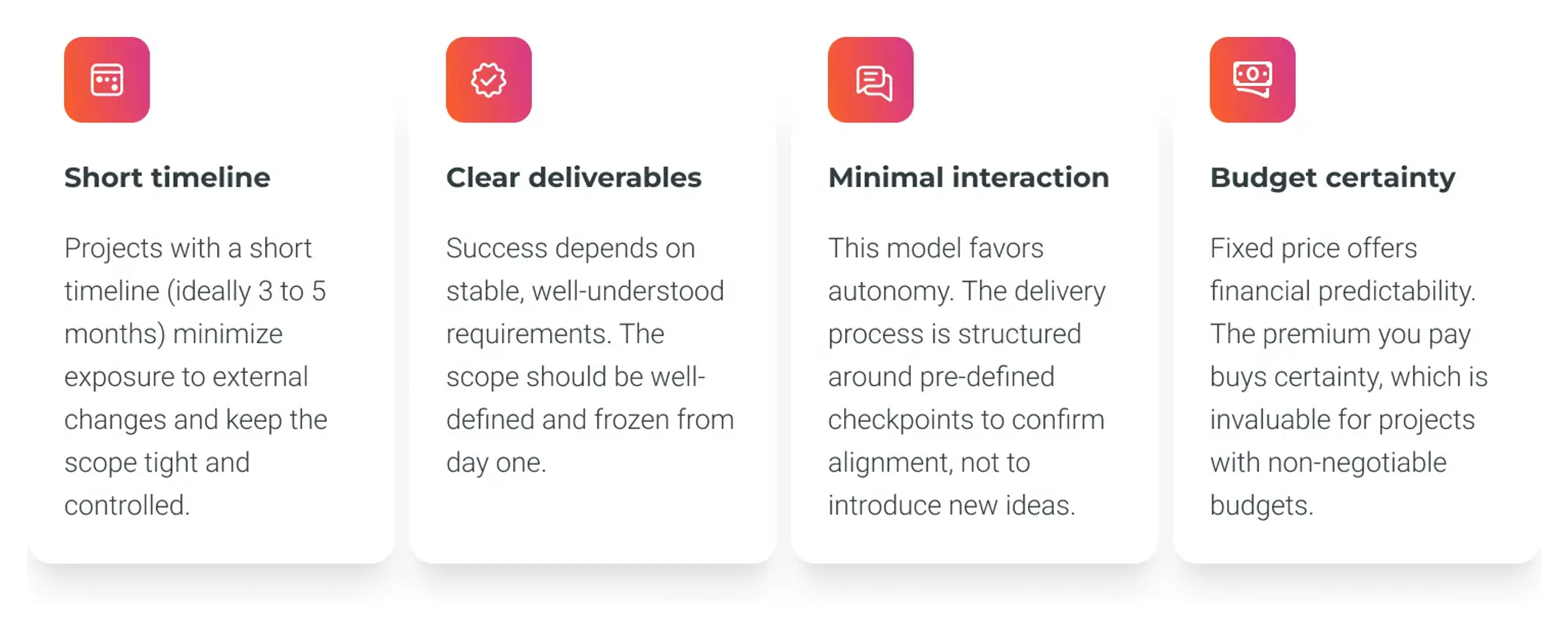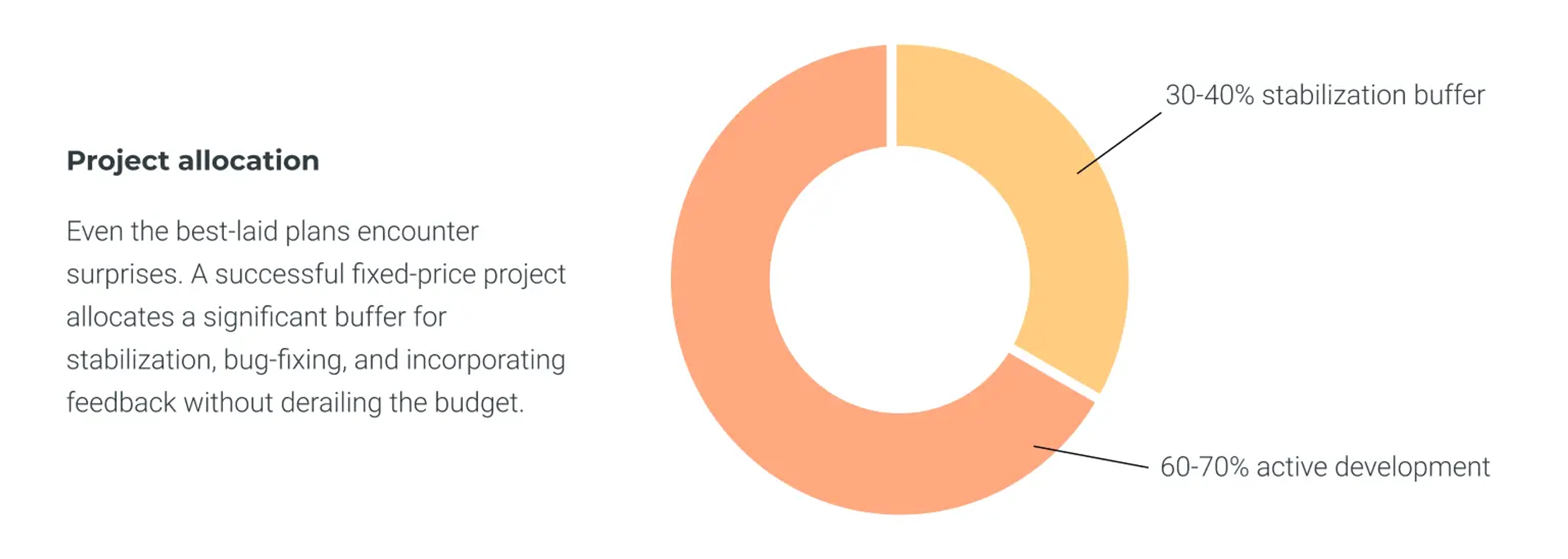

Diego Santillan
Co-Founder & COO
When you’re considering a custom software project, the engagement model you choose directly impacts your business outcomes. In 2025, fixed price software remains a popular choice for a reason: it delivers predictability and financial discipline, qualities every decision-maker values when stakes are high and budgets are non-negotiable. Yet, many leaders aren’t clear on when fixed price is the right fit for their business.
Over the past 25 years at CloudX and in previous roles, I’ve led dozens of successful fixed price projects, and also learned hard lessons from the few that didn’t go as planned. My goal here is to distill that experience into a practical, strategic guide. If you’re asking, “is fixed price software right for my project?”, this article is for you.
In a previous article, I compared fixed price software to an all-inclusive vacation package: you pay one price, get a defined set of deliverables, and expect no surprises. Similarly, a fixed price engagement is best when your destination and itinerary are clear from the start. If you know exactly what you want and don’t plan to change course, this model delivers the predictability you need.
Fixed price is a strong fit for projects with these characteristics:
Conversely, fixed price is a poor fit when:

Let me illustrate with examples from CloudX. Recently, we partnered with an insurance client to build an offline quoter as a fixed price project. Their needs were 100% identified, and the scope was crystal clear. This is the ideal scenario: a well-established industry, aiming to digitally transform a very familiar process. The project was short, perfectly defined, and executed using Waterfall methodology. Everything ran smoothly.
Contrast this with a recent experience we had with a startup in the energy sector. They approached us with a brilliant, innovative idea, but their requirements and dependencies were largely undefined: a textbook example of when fixed price is not the right fit. During our pre-sales process, several red flags emerged that ultimately led us to decline the project. The client attempted to introduce fixed price controls into the Agile plus Time & Materials (T&M) framework we had proposed; requests that would have created ambiguity and added unnecessary stress to the team. Unfortunately, this meant we couldn’t reach an agreement.
This is a common scenario among startups: founders often have a strong vision and a compelling idea, but many details are still pending definition and budgets are limited. That’s entirely normal for an early-stage company, and in these cases, a T&M plus Agile approach is far more effective. It gives you the flexibility to run a proof of concept, test feasibility, and explore different solutions and technologies, while also laying the groundwork for future scalability as the product and business model evolve. Moreover, when requirements aren’t fully defined and the approach is likely to change, fixed price can quickly exhaust your budget without delivering real progress.
A possible workaround for non-ideal cases is to break the work into smaller, fixed-price modules, each with a defined scope, timeline, and acceptance criteria. This can help in some situations, but isn’t always feasible. My advice: if you’re unsure whether fixed price is right for you, don’t choose it. But if you do, accept that change will be limited.
Here’s what I’ve learned about maximizing the probability of success in fixed price projects.
Define what will be delivered and what won’t. Both must be explicitly documented and signed off. There should be zero ambiguity about what’s being built, how it will be validated, or what “done” means.
In my experience, most clients requesting fixed price projects have about 20% of scope elements loosely defined. In problematic projects, that figure can exceed 50%. If you can’t confidently define and freeze the majority of the scope, fixed price is likely the wrong model. In that case, T&M or a paid discovery phase are better options..
Keep the timeline short. Ideally, the project should last between 3 to 5 months. Shorter timelines help ensure the scope remains well-controlled and reduce the risk of shifting business priorities or market changes derailing the project. Trying to manage a longer fixed price engagement inevitably leads to outdated assumptions and creeping misalignment.
Estimation should be grounded in task-level effort. The team in charge must break the agreed scope into concrete tasks, estimate the effort for each, and build the delivery timeline from the bottom up.
Even with clear scope and intermediate milestones to check progress and give feedback, surprises happen. In estimation, active development shouldn’t exceed 60-70% of the total timeline. The remaining 30-40% should be reserved as a buffer for eventualities and stabilization, including bug-fixing and client feedback. For example, if development is estimated at 12 weeks, a 15-17 week timeline is realistic and still keeps the project short.

Ideally, scope is fixed and no changes are requested during development. But justified changes do arise, so plan a process in advance. Change requests should be managed with structure and discipline, considering the impact of new requirements on scope, budget, and timeline. Define a window for accepting change requests, and stick to it. A well-structured change process benefits both parties: you maintain control, and your technology partner avoids chaos or overruns.
This doesn’t mean every adjustment will be rejected, but change requests should be batched, carefully scoped, and treated as separate negotiations. My internal rule: if cumulative change requests exceed 15–20% of the original budget, fixed price was likely the wrong model. In those cases, plan those changes into a follow-up fixed price project.
In a well-structured fixed price engagement, it’s essential to minimize the frequency and depth of client-vendor interaction during execution. Unlike Agile projects where continuous collaboration and evolving requirements are core, fixed price software thrives on predictability and autonomy. Two things ensure alignment without disrupting scope:
Fixed price projects require fewer checkpoints, so autonomy is fundamental. The team must be capable of making the right decisions without constant oversight. Rely on senior professionals who know when to flag issues, when to seek clarification, and how to keep delivery on track without micromanagement. Staffing the project with the ideal engineers should be your technology partner’s responsibility, not yours.
Success depends on mutual trust and a shared commitment to the project’s goals. Both client and vendor want the same outcome: a successful delivery. It’s essential to approach the relationship as a partnership, an alliance.
When unexpected changes, renegotiations, or setbacks occur, tensions can arise. In these moments, we shouldn’t let frustration or rigidity erode the relationship. Instead, we must embrace flexibility and open communication. Despite best efforts, some degree of adaptation may be necessary. When both parties remain conscious of the bigger picture and act in good faith, you protect not only the current project, but also the potential for future collaboration. A strong partnership is a strategic asset that can deliver compounding returns well beyond the initial engagement.
To help you make a confident decision, I’ve included a quick self-assessment below. Use this quiz to clarify which engagement model best fits your project’s needs.
1. What best describes your project?
A) Low complexity, well-defined
B) Evolving, complex, or innovative
2. How would you describe your project’s scope?
A) Clear, stable, and fully documented
B) Flexible, I expect requirements to change
3. How much flexibility do you need during development?
A) Minimal, changes should be rare
B) High, changes are expected
4. How important is budget predictability?
A) I need to know the total cost up front
B) I’m comfortable with some variability
5. What’s your estimated project timeline?
A) Up to 5 months, with a fixed end date
B) Likely longer than 5 months, or flexible
6. How involved do you want to be after kickoff?
A) I’m comfortable with some milestone check-ins
B) I’d like close collaboration with the team
7. What’s your pricing preference?
A) Willing to pay a premium for certainty
B) Prefer to pay for work delivered, even if variable
If you answered mostly A’s, a fixed price engagement is likely a strong fit, especially if you value predictability, have a well-defined scope, and want minimal surprises.
If you answered mostly B’s, Time & Materials (T&M) with Agile is probably your best path. You’ll benefit from ongoing collaboration and the ability to adapt as your project evolves.
In case you’re still unsure, feel free to reach out to partnerwith@cloudx.com. I’ll be happy to help you make the right call for your business.

Insights
Fixed price software is like booking an all-inclusive vacation: you pay one price, get a defined set of deliverables, and expect no surprises. In this article…

Insights
CloudX announced today that more than 300 of its employees worldwide are now AI-certified, making it the first company to achieve full AI accreditation across…

Insights
Bridging the gap between a Generative AI prototype and an enterprise AI solution demands more than technical tweaks: it requires a disciplined, strategic…